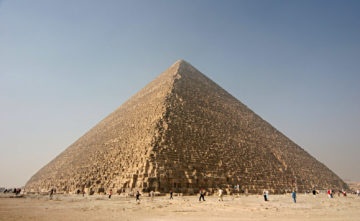by Nate Sheff
 Not long ago, I went to the Yale University Art Gallery and saw their collection of Egyptian art. Seeing the dates on some of the pieces, it occurred to me that I had never really considered just how old Egyptian civilization is. I looked up some historical events to get perspective, and learned that I am closer in time to the assassination of Julius Caesar (44 BCE, which is 2,066 years ago) than Julius Caesar was to the construction of the Great Pyramid of Giza (circa 2500 BCE, over 2,400 years before Caesar’s death). Caesar’s death is ancient history, and the building of the Great Pyramid is also ancient history, but – for the sake of perspective here – the Great Pyramid’s construction was also ancient for Julius Caesar. That’s how old Egyptian civilization is.
Not long ago, I went to the Yale University Art Gallery and saw their collection of Egyptian art. Seeing the dates on some of the pieces, it occurred to me that I had never really considered just how old Egyptian civilization is. I looked up some historical events to get perspective, and learned that I am closer in time to the assassination of Julius Caesar (44 BCE, which is 2,066 years ago) than Julius Caesar was to the construction of the Great Pyramid of Giza (circa 2500 BCE, over 2,400 years before Caesar’s death). Caesar’s death is ancient history, and the building of the Great Pyramid is also ancient history, but – for the sake of perspective here – the Great Pyramid’s construction was also ancient for Julius Caesar. That’s how old Egyptian civilization is.
Four-and-a-half millennia is a long time on a human timescale, but not all timescales are human. A core sample from Methuselah, a bristlecone pine living – alive – in the White Mountains of California, shows the tree to be about 4,800-years-old. By the time they started building the Great Pyramid, Methuselah had already spent a couple centuries photosynthesizing on a mountainside, adding rings but not counting them.
Methuselah is the oldest known non-clonal tree. When we consider trees that can reproduce asexually, say, by growing new individuals from existing root systems, we find organisms like Pando, a colony of genetically-identical quaking aspens in Utah, estimated to be about 15,000-years-old. Pando had been alive for several thousand years before Göbekli Tepe, the site of the earliest known megaliths, appeared in Anatolia.
Think of how many generations of birds might have started their lives in Pando’s branches by then.
It’s astonishing and impressive that a single lifetime could span so many years, but does this imply anything about the value of these lives? We can grant the aesthetic claims easily – what about the ethical claim that these beings could be valuable in their own right, ends in themselves? Part of the charm of ancient organisms is how inhuman they are, how they have been quietly making their way independently of all the messy human goings-on. But since so much of what we find valuable has to do with us and our lives, it’s hard to find a place for these beings in our ethical outlook. If value only has its place within a human point of view, then maybe things like trees just can’t fit. They might be pretty, but ultimately unimportant.
Many philosophers find it hard to resist the pull of sentientism, the idea that, at minimum, something needs to be conscious or aware in order to be a subject of moral concern. While it’s controversial whether more is needed for full-fledged membership in the moral community, many take it for granted that consciousness is required. Hence the anxiety about the ethics of creating artificial intelligence; intelligence, artificial or not, counts for something from the moral point of view. Although a brave few defend the possibility of plant intelligence (including Charles Darwin and his “root-brain” hypothesis), most accept that plants can neither think nor feel, and so cannot belong to the moral sphere.
We can remain agnostic on sentientism and plant intelligence, and still maintain that we have a lot to learn from our appreciation of the radical independence of beings like Methuselah and Pando. In his meditation on the Pale Blue Dot photograph of Earth, Carl Sagan said that studying astronomy is a “humbling and character-building experience.” And he was right. The more you know, the sillier it feels to think you’re at the center of everything. But this gift isn’t uniquely given by astronomy, or its more easy-going sibling, star-gazing. Go hiking in the right woods, and you can find yourself standing beneath glacial erratics, boulders the size of houses deposited thousands of years ago by receding glaciers. Take a walk on the right beach, like the geologist James Hutton did, and you might find evidence of Earth being hundreds of millions years old.
According to philosopher Thomas Hill Jr., these encounters (whether in person, in books, in films) can afford us a new perspective capable of inspiring proper humility.[1] This isn’t to be confused with low self-esteem or feeling that nothing matters. Rather, it is an appreciation of one’s place in the world, and an acceptance of oneself as a natural being. From this point of view, we can regard the natural world as, in the words of philosopher Holmes Rolston III, a great generative matrix, the causal source of ourselves and everything else.[2] Pando and Methuselah represent autonomous branches of a sprawling family tree that includes us and them. Outside human concerns and independent of them, the big generative matrix pushes silently on. For Hill, the appreciation of this state of affairs isn’t just aesthetically pleasing. It signals a deepening understanding of our situation, and the more clearly we see how things stand, the better we become as human beings.
1. Hill argues this as part of a virtue-theoretic approach to environmental ethics in his essay “Ideals of Human Excellence and Preserving Natural Environments.”
2. This is in Rolston’s “Values Gone Wild.”
